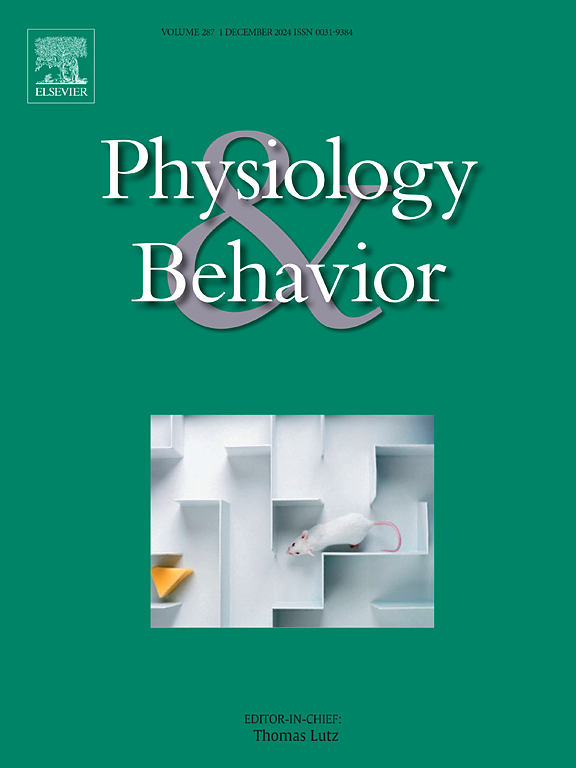警告的生理代价:防御性嘶嘶声会增加毒蛇的新陈代谢率和蒸发性失水。
IF 2.4
3区 医学
Q2 BEHAVIORAL SCIENCES
引用次数: 0
摘要
为了最大限度地降低捕食风险和与捕食者对抗的成本,猎物发展出了一系列防御策略和警告信号。防御性警告虽然有利,但也会使发出者付出生理和能量代价。呼吸声(嘶嘶声)是脊椎动物中分布最广的警告声。由于涉及呼吸器官,防御性嘶嘶声可能会大大增加蒸发性失水。在这里,我们研究了中型毒蛇长吻蝰发出嘶嘶声的决定因素及其生理代价。我们首先使用一个中性竞技场,并使用标准化刺激来测量警告性嘶嘶声的发生和声学特征。然后,我们使用开流呼吸测定法量化防御反应过程中呼吸气体交换(耗氧量和蒸发失水)的变化。我们证明,雄性在受到刺激时更有可能发出声音警告。与吸气相比,呼气产生的信号最强,但性别之间并无差异。我们发现,在 10 分钟的刺激期间,防御性嘶嘶声会显著增加平均代谢率和蒸发性失水,这种效应在雄性中更为明显。代谢率和蒸发失水与嘶鸣持续时间密切相关。总之,我们的研究结果表明,基于呼吸的警告声会导致巨大的生理代价,并可能改变水平衡。雄性比雌性的反应性更高,这可能反映了性选择压力(为获得配偶而具有更高的流动性)和更高的风险暴露。本文章由计算机程序翻译,如有差异,请以英文原文为准。
Physiological costs of warning: Defensive hissing increases metabolic rate and evaporative water loss in a venomous snake
To minimize predation risk and the cost of confronting predators, prey have developed a range of defensive strategies and warning signals. Although advantageous, defensive warnings may also induce physiological and energy costs to the emitter. Ventilatory sounds (hissing) are the most distributed warning sound in vertebrates. Because they involve the respiratory apparatus, defensive hissing may substantially increase evaporative water loss. Herein, we examined the determinants of hissing as well as its physiological costs in a medium-sized venomous snake, the long-nosed viper (Vipera ammodytes). We first used a neutral arena and applied standardized stimulation to measure the occurrence and acoustic characteristics of warning hissing. Then, we used open-flow respirometry to quantify changes in respiratory gas exchanges (oxygen consumption and evaporative water loss) during defensive responses. We demonstrated that males are more likely to engage in sound warnings when stimulated. Expirations generated the strongest signals compared to inspiration but did not differ between sexes. We found that defensive hissing dramatically increased average metabolic rate and evaporative water loss during the 10-minute stimulation period, and this effect was more pronounced in males. Metabolic rates and evaporative water loss were closely related to the duration of hissing. Overall, our results indicate that respiratory-based warning sounds induce significant physiological costs and may alter water balance. The higher responsiveness in males than females likely reflects sexually selective pressure (higher mobility for mate acquisition) and enhanced risk exposure.
求助全文
通过发布文献求助,成功后即可免费获取论文全文。
去求助
来源期刊

Physiology & Behavior
医学-行为科学
CiteScore
5.70
自引率
3.40%
发文量
274
审稿时长
47 days
期刊介绍:
Physiology & Behavior is aimed at the causal physiological mechanisms of behavior and its modulation by environmental factors. The journal invites original reports in the broad area of behavioral and cognitive neuroscience, in which at least one variable is physiological and the primary emphasis and theoretical context are behavioral. The range of subjects includes behavioral neuroendocrinology, psychoneuroimmunology, learning and memory, ingestion, social behavior, and studies related to the mechanisms of psychopathology. Contemporary reviews and theoretical articles are welcomed and the Editors invite such proposals from interested authors.
 求助内容:
求助内容: 应助结果提醒方式:
应助结果提醒方式:


